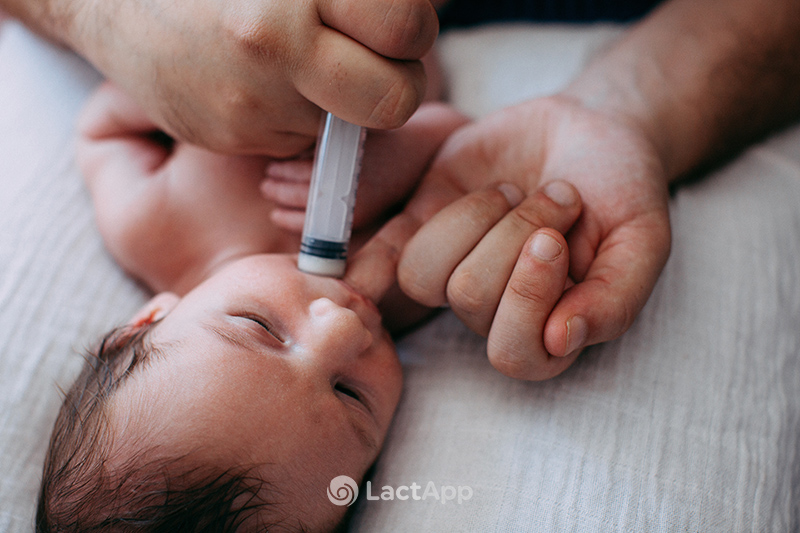
The finger-syringe technique of supplementing
When a baby needs to receive additional breastmilk or formula milk, we always think of a bottle as the only way to do this. And, of course, you can give milk in a bottle; you just need to know the advantages and disadvantages of each supplementing method. In this post, we will explain the finger-syringe technique.
What advantages does it have over other methods?
The finger-syringe method is ideal for training babies’ suckling motions. It allows your baby to place the tongue in a position similar to what they would do when feeding at the breast. This method allows the milk to be given as the baby is suckling and ensures that the baby gets the amount of milk they need. It is also ideal for very sleepy babies, as they do not need to be awake to be able to suck.
What do I need to buy?
To perform this technique, you only need a syringe without a needle. Different types of syringes, from normal to curved, can be used.
Curved syringes can be a little more complicated to find, as you might have to order them online, but they ensure a more precise administration of milk. The main difficulty is that they have a limited capacity (12ml), so you must refill the syringe often if the baby is hungrier.
Common syringes are easy to find and cheap. They come in different sizes, which can simplify supplementing if the baby drinks larger amounts of milk.
These common syringes can also be fitted with a soft silicone adapter that makes the experience more pleasant for your baby as then the milk comes out from a further point inside their mouth, getting closer to the point where the nipple reaches when the baby is breastfeeding.
Can I give my baby milk with a syringe only?
No, you should always simultaneously put your finger into your baby’s mouth. The finger resembles the nipple, letting your baby know they must swallow the milk. Without the finger in the mouth, there is more risk of choking, or the baby does not know how to perform the sucking motions.
When should the finger-syringe technique be used?
This technique is great during the baby’s first few days when they are still having small amounts of breastmilk. It is also perfect for babies who need supplementing because they are too sleepy or too weak for suckling.
Although this method is recommended for this first stage, it can also be used for babies of any age. Many families choose this method when the mother returns to (paid) work, and the baby does not accept other methods of supplementing milk.
How do I do this?
Wash your hands thoroughly and trim the fingernail of the finger you will use to give the milk as short and clean as possible.
Prepare the milk and syringe, and sit with your legs elevated at an angle so your baby lies inclined on your lap and is face-to-face with you.
If you don’t feel comfortable in this position, you can use a baby rocking chair, or someone else can hold your baby, or you can even put pillows under your baby’s back.
The baby should remain seated, almost upright, with the head higher than the bottom.
- Carefully, with the palm of the hand facing upwards, insert your little finger (or the one that most closely resembles the diameter of the nipple) into your baby’s mouth.
- Try to touch the upper part of the palate, as touching this point activates the baby’s sucking reflex.
- Place the syringe at the corner of the baby’s mouth, or in the case of a curved syringe, put it into the baby’s mouth by placing it on the finger.
- The tongue will be placed down, so apply a little force so the baby does not close the mouth too much.
- When the baby starts with sucking motions (you will notice the movements of the tongue from the nail towards the middle of your finger), squeeze the syringe a little so that the milk comes out.
- You will see your baby suckling and resting, but always follow your baby’s rhythm and pause at all times so they can drink the amount of milk they need.
- If the syringe is finished, fill up more milk until the baby no longer wants more.
Should I do this as the mother, or is it better if someone else does it?
It doesn’t matter if you want to do this yourself or prefer your partner or another family member to do it. It’s ok either way, and your baby won’t get confused if you give the milk in this way as the breastfeeding mother. If you feel like doing this or you’re alone, go ahead. If your baby is awake, look for eye contact while you give the milk and talk about what you are doing so that your baby stays relaxed and calm.
Are there any risks of this technique?
The main risks may be:
- Risk of harming the baby: This can be avoided if your fingernail is cut very well and you are very careful when you put your finger into your baby’s mouth. Also, the syringe needs to be carefully placed in the corner of the baby’s mouth.
- Getting used to it: if the milk is given slowly and you always try to offer your breast first, the baby should not get used to the syringe. If your baby gets used to it, you can offer the breast with the syringe close to your breast, supplementing while you are feeding at the breast, encouraging your baby to feed directly from your breast.
Please also see the video below, as it is always easier to learn with images:
To learn more about breastfeeding or if you have any other questions, download our free app, Lactapp, for Android or iPhone.